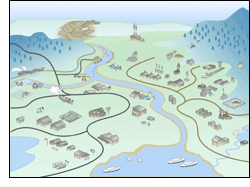Contaminated Sites:
 What
is a contaminated site?
What
is a contaminated site?Contaminated sites are sites that are known, or suspected, to pose significant risks to the Tribal community, its traditional practices, and/or subsistence resources. It may be a site that is contaminated by old mining wastes, metals, organic and inorganic chemicals, and other hazardous substances that present human health risks through releases to soil, air, ground and surface waters and sediment. These sites may also threaten sensitive habitats for plants, fish, and wildlife.
It is impossible to describe the "typical" contaminated site because they are all so very different. Many are landfills. Others are manufacturing plants where operators improperly disposed of wastes. Some are large federal facilities with different areas of contamination from various military activities. Transportation spills, other industrial processes, natural disasters, or storage accidents account for some hazardous waste releases. The result can be fires, explosions, toxic vapors, and contamination of groundwater used for drinking.
Is there an area or site in or near your community that residents are concerned about? Your site(s) may be identified with one or more of the federal programs/databases listed below under Related Pages. However, many contaminated sites are not listed on the federal or even on the state level.
Contaminants of Concern:
Each contaminated site will have different contaminants of concern. Most can be found searching online for fact sheets associated with each site or comparable sites. Contaminants may include, but are not limited to:Inorganic pesticides
Organic pesticides
Halogenated solvents
Petroleum compounds
Metals
Radionuclides
Explosives
Implementing Solutions:
Brownfields programs can help facilitate the assessment of contaminated sites.You can petition the Agency for Toxic Substances and Disease Registry (ATSDR) to request a public health consultation regarding a hazardous waste site or facility. Details are available at ATSDR's Division of Health Assessment and Consultation website. An example of an ATSDR public health assessment for USAF Galena Air Force Station is located HERE.
Please submit your experiences (successes/challenges) and tribal-specific documents to share on our website using the attached form.
Download Form
Resources:
Possible/Probable Contaminants Related to Land Uses [pdf]Tribal Hazardous Sites 2004 Report [pdf]
OSHA Guidance Manual [pdf]
EPA Science and Ecosystem Support Division Waste Sampling Guidance [pdf]
Websites:
Office of Emergency Management (EPA):www.epa.gov/oem/
Cleaning Up Our Land, Water, and Air:
www.epa.gov/cleanups
How to find, determine, and assess a contaminated site:
Environmental Justice Viewer (find federally registered hazardous sites) (EPA):
www.epa.gov/ejscreen
National Priorities List (EPA):
www.epa.gov/superfund/superfund-national-priorities-list-npl
Hazard Ranking System (mechanism EPA uses to place uncontrolled waste sites on the NPL):
www.epa.gov/superfund/introduction-hazard-ranking-system-hrs
CLU-IN (Contaminated Site Clean-up Information):
www.clu-in.org/
Related Pages:
BrownfieldsCoal Mining
Federal Facilities
Mining
Common contaminated sites include: landfills, manufacturing plants, transportation spills, storage accidents, abandoned buildings, old fuel-storage tank farms, old canneries and fish processing facilities, abandoned or inactive dumpsites, logging camps, old civilian federal facilities such as schools and hospitals
For more information, please contact:
Jennifer Williams, Alaska Program Coordinator, Sr.
Tel: 928/523-0673
Email: Jennifer.Williams@nau.edu
Tel: 928/523-0673
Email: Jennifer.Williams@nau.edu
Last updated: July 10, 2015
